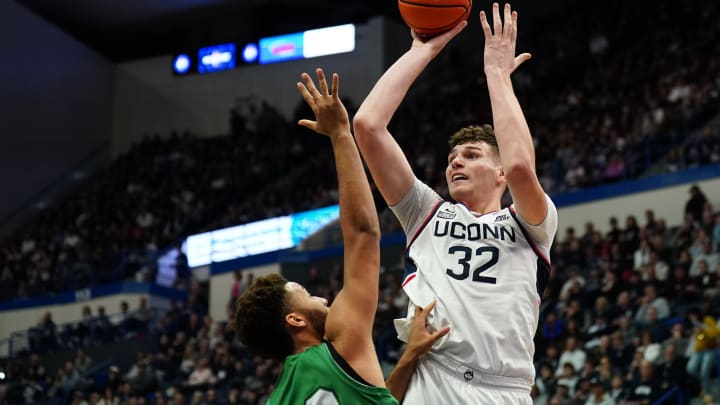The Productive Sophomore Query: A February Update for the 2024 NBA Draft

The utilization of statistical queries to discover basketball talent has increased in popularity in recent years. While I wrote an article to review the players who are currently meeting the threshold for the Productive Young Athlete query last week, which has a "stick" rate of 78%, the Productive Sophomore Query applies the same three criteria to sophomores instead of freshmen.
Described in-depth in an article from last June, there were 104 sophomores throughout the ten college seasons from 2010-2019 who played at least 40% of their team's minutes, had a Box Plus-Minus of at least +7.5, and met the minimum athletic threshold of four total dunks. Exactly 50% of them played five-plus years in the NBA or are currently in the NBA. The purpose of this query is to find players who are still underclassmen (but not freshmen) that are being trusted to play almost a majority of their team's minutes, meet a certain production threshold, and also meet a minimum athletic threshold throughout the season.
As discussed further in the December update, after diving back into the data, I discovered increasing the Box Plus-Minus thresholds leads to an increase in "stick" rate. When you increase the threshold to +8.0 Box Plus-Minus and keep the MIN% and dunk threshold constant for sophomores, the "stick" rate jumps to 55%. Next, increasing the threshold from +8.0 to +8.5 BPM leads to a 64% "stick" rate. Lastly, 71% of sophomores who played at least 40% of their team's minutes, had a Box Plus-Minus of at least +9.0, and met the minimum athletic threshold of four total dunks played five or more years in the NBA or are currently in the NBA.
Introduction
Before we dive into the statistical analysis, it’s important to define what “stick” means in my study. In this case, I considered a prospect to “stick” if they played five or more seasons in the NBA. Prospects in the 2019 NBA Draft met the criteria of “sticking” if they are still in the league, due to the impossibility of them reaching five NBA seasons.
As of February 13th, 2023, there are six players on track to meet the Productive Sophomore Query (50%+ threshold) for the 2024 NBA Draft. The four are split up into four separate Box Plus-Minus thresholds for sophomores. Each separate threshold has a different "stick" rate and sample size that will be mentioned.
Productive Sophomore Query: 50% threshold
Joshua Jefferson, Saint Mary's (7.7 BPM)
One player is on track to meet the 7.5+ Box Plus-Minus threshold of the Productive Sophomore Query in which 50% of players who played at least 40% of their team's minutes, had a Box Plus-Minus of at least +7.5, and met the minimum athletic threshold of four total dunks "stick" in the NBA. This player is Joshua Jefferson at St. Mary's.
Jefferson is listed at 6-foot-8, 220 pounds, and is averaging 10.2 points, 2.3 assists, 6.5 rebounds, 1.2 steals, and 0.4 blocks per game in 24.9 minutes per game. He's converting 65.1% of his attempts at the rim (86 attempts), 40.8% of his non-rim twos (71 attempts), 41.2% of his dribble jumpers (only 17 attempts), but is only shooting 25.4% on catch-and-shoot threes (59 attempts). However, the sophomore is converting 73.1% of his free throw attempts (52 attempts) -- which would indicate a slightly better 3-point percentage than the 26.7% he's currently shooting on all triples.
He appears to be making an impact on the game in other ways as well, recording a 7.1 offensive rebounding percentage, 23.8 defensive rebounding percentage, 18 assist percentage, 3.1 steal percentage, and 1.7 block percentage.
Joshua Jefferson says thank you very much, and slams it home! #GaelsRise pic.twitter.com/El5a0ykN4f
— Saint Mary's Hoops (@saintmaryshoops) February 11, 2024
Productive Sophomore Query: 55% threshold
Ryan Dunn, Virginia (8.3 BPM)
One player is on track to meet the 8.0+ Box Plus-Minus threshold of the Productive Sophomore Query in which 55% of players who played at least 40% of their team's minutes, had a Box Plus-Minus of at least +8.0, and met the minimum athletic threshold of four total dunks "stick" in the NBA (sample size of 78 prospects). This player is Ryan Dunn at the University of Virginia.
Widely regarded as one of the best defenders in college basketball, Dunn is listed at 6-foot-8, 208 pounds, and is recording a 3.5 steal percentage and 10.4 block percentage. He's also an active rebounder, recording seven rebounds per game with a 10.2 offensive rebounding percentage and 20.6 defensive rebounding percentage.
The large question with Dunn is how he can provide value to an NBA team on the offensive end of the floor. In the last five games dating back to Jan. 31, Dunn is only averaging 3.4 field goal attempts per game -- including two games with zero attempts and one attempt.
Dunn has only attempted 25 catch-and-shoot threes all season and is shooting 24% on those attempts. Additionally, the sophomore is only converting 56.1% of his free throws this season (66 attempts). Luckily, Dunn's converting 72.3% (101 attempts) of his attempts at the rim this season and he's in the 88th percentile in points per possession on cuts. Lastly, while only on 33 possessions, Dunn ranks in the 93rd percentile in points per possession in transition possessions he's involved in.
Ryan Dunn flies around the court as much as advertised defensively.
— Adam Finkelstein (@AdamFinkelstein) February 6, 2024
He doesn’t get nearly enough credit for how well he transitions from defense to offense though. In large part because Virginia is 361st in the country in adjusted tempo. https://t.co/e4YRyc2Fzu pic.twitter.com/Cf2E8iYiP6
Productive Sophomore Query: 64% threshold
Two players are on track to meet the 8.5+ Box Plus-Minus threshold of the Productive Sophomore Query in which 64% of players who played at least 40% of their team's minutes, had a Box Plus-Minus of at least +8.5, and met the minimum athletic threshold of four total dunks "stick" in the NBA (sample size of 55 prospects). The two players are Alex Karaban of UConn and Richie Saunders at BYU.
Alex Karaban, UConn (8.7 BPM)
Karaban is a 6-foot-8, 210-pound sophomore known for his 3-point shooting ability. He's averaging 14.7 points, 5.6 rebounds, 1 steal, and 0.9 blocks per game while converting 73.9% of his attempts at the rim (88 attempts), 45.5% of his non-rim twos (22 attempts), and shooting 40.2% from beyond the arc on 5.5 attempts from deep point attempts per game and 10.6 attempts per 100 possessions. Additionally, he has converted 83.7% of his free throw attempts over the past two seasons (86 attempts) while recording a 5.8 offensive rebounding percentage, 1.8 steal percentage, and 2.9 block percentage this season. Lastly, it should be noted that he did redshirt his first season at UConn so he will turn 22 years old a few weeks into the 2024-25 NBA season.
Make it 15 for Karaban! 💦@AlexKaraban x @UConnMBB pic.twitter.com/qeQH9PfN2b
— FOX College Hoops (@CBBonFOX) February 10, 2024
Richie Saunders, BYU (8.7 BPM)
A lesser-known player, Saunders is a 6-foot-5, 200-pound sophomore for BYU that's averaging 9.5 points, 4 rebounds, and 0.9 steals in 20 minutes per game this season. He's shooting 34.8% from three (7.8 3PA/100) and, more specifically, 37% on catch-and-shoot threes (60 attempts). Additionally, he's converting 79.7% of his attempts at the rim (59 attempts), 42.5% of his non-rim twos (40 attempts), is recording an 8.1 offensive rebounding percentage, and a low 4.6 turnover percentage. However, he's only converting 69.5% of his free throws over two seasons (82 attempts).
While he has potential as a catch-and-shoot player, his shooting form is unique and feels like it has many moving parts despite the good elevation he gets on it.
Furthermore, the two main questions with him are: How else can he provide value to an NBA team? Is the on-ball defense good enough? While not quite a serious prospect right now, he could be someone to watch if his minutes increase next season and his productivity continues.
Productive Sophomore Query: 71% threshold
The last Productive Sophomore Query threshold is one that has a 71% stick rate in a sample size of 41 prospects. Two players are on track to meet the 9.0+ Box Plus-Minus threshold of the Productive Sophomore Query in which 71% of players who played at least 40% of their team's minutes, had a Box Plus-Minus of at least +9.0, and met the minimum athletic threshold of four total dunks "stick" in the NBA). The two players are Kyle Filipowski and Donovan Clingan.
Kyle Filipowski, Duke (9.3 BPM)
Filipowski is a 7-foot, 230-pound big man for Duke. Before diving into the statistics and advanced metrics, feel free to check out my offensive breakdown on Filipowski's game as well as my defensive breakdown.
Filipowski is intriguing as an offensive prospect, but comes with question marks. If you believe that he can continue to develop his jumper, then a 7-footer who can shoot off of pick-and-pops, is a fluid driver, and can make sound decisions with the ball in his hand is a solid baseline.
However, if a scout doesn't believe in his shot, they may wonder what role Filipowski could fill offensively in the NBA.
Does he develop further as a driver or self-creator? Is he good enough in the post to be an offensive hub in that area and utilize his passing ability? Could he fulfill a role where he provides value as a finisher and passer from the short roll? The latter is most likely, as the short roll would combine his strengths in decision-making and soft touch (when not bothered by length), yet it's still a difficult projection due to his lack of repetitions in that area.
Defensively, Filipowski could project to be a Mobile Big in the NBA. While he would likely need to continue improving his lateral quickness and foot speed to have the same impact at the NBA level as he does at Duke, he's undoubtedly shown potential in containing drivers, switching, and executing show coverage.
Filipowski is averaging 17.4 points, 2.8 assists, 8.3 rebounds, 1.1 steals, and 1.8 blocks per game while shooting 49.8% from the field, 34.5% from three, but only 64.6% from the free throw line this season (76.5% from the line last season). He's also recording an 8.6 offensive rebounding percentage, 23 defensive rebounding percentage, 18 assist percentage, 2.2 steal percentage, and 6.4 block percentage.
Donovan Clingan, UConn (11.7 BPM)
Clingan is a 7-foot-2, 265-pound big for the Huskies that's averaging 12.2 points, 6.4 rebounds, and 2.1 blocks per game in only 20.5 minutes per game. He's one of the best offensive rebounders in the country statistically, recording a 15.9 offensive rebounding percentage. Additionally, he's garnered a 15.5 assist percentage, 10.7 block percentage, and 0.9 steal percentage.
While he's converting 70.1% of his attempts at the rim (107 attempts) and 50% of his non-rim twos (38 attempts), his beyond-the-arc shooting indicators are not the best. Over two seasons and 166 attempts, Clingan is only converting 51% of his free throw attempts and has attempted five total threes this season (made one). However, Clingan is in the 98th percentile in points per possession generated in Post Ups Including Passes possessions -- meaning he can likely still be effective at the next level offensively at the next level without an outside shot.
donovan clingan is moving his feet well in high drop this season, changing directions and containing drives, the footwork stuff is gonna have to be great to make up for some of his athletic limitations pic.twitter.com/a31ZORBIUW
— ben pfeifer (@bjpf_) February 8, 2024
All play-by-play data referenced is courtesy of Synergy Sports.
Want to join the discussion? Like Draft Digest on Facebook and follow us on Twitter to stay up to date on all the latest NBA Draft news. You can also meet the team behind the coverage.
